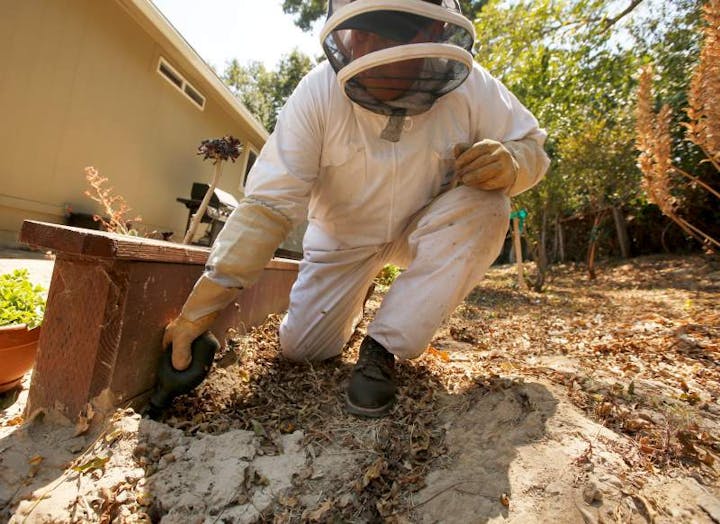Yellowjackets
Yellowjackets are aggressive, stinging wasps from the genus Vespula and Dolichovespula that typically have a yellow and black banded abdomen. There are several local species that fit this description. Yellowjackets can easily be distinguished from paper wasps, which comparatively have a longer waist and legs.
Life cycle & habitat
Ground-nesting yellowjackets construct paper nests that may contain thousands of larvae and adult workers. These nests are typically located underground in abandoned rodent burrows or in other enclosed spaces such as tree cavities, wall cavities, wood piles, and dense ivy. During the fall, young queens mate and find protected areas (such as fallen logs, tree cavities, cracks in buildings, etc.) where they remain for the duration of the winter. When spring arrives, queens select nesting sites and begin the process of colony initiation (nest construction, deposition of eggs, and hunting for food). Once adult workers emerge, they take over many of the tasks of nest maintenance so that the queen can remain within the safety of the nest and lay eggs. Foraging ground-nesting yellowjacket workers commonly come into contact with people who are eating outdoors and may become extremely aggressive. The colony grows throughout the summer and into fall, and eventually begins production of males and queens. When rain and/or freezing temperatures return, nests typically die out, and newly mated queens find protected areas to overwinter so the process can begin anew in the spring.

Impact on human health
- Female yellowjackets can sting repeatedly, and some individuals may be sensitive to their venom.
- Ground-nesting yellowjacket foragers may become aggressive in outdoor eating areas.
- Aerially-nesting yellowjackets are insectivorous and therefore typically do not become troublesome in outdoor eating areas.
- Both ground and aerial-nesting yellowjackets will aggressively defend their nests if disturbed.
Control
- The District provides free control of ground nests for residents of Marin and Sonoma counties when the location of the nest is known. Click here to request this free service, or visit our Yellowjacket Control Program page.
- The District does not control yellowjackets that are nesting aerially or within structures. Residents may contact a private pest control company for the removal/destruction of these nests.
What you can do to prevent exposure
- Do not disturb nests.
- Do not go barefoot outdoors.
- Do not attempt to swat yellow jackets with your hands.
- Use lids on sweetened drinks.
- Keep garbage away from eating areas.
- If eating outside, check the food before placing it in your mouth.
Useful links
UC IPM Pest Notes: Yellowjackets and Other Social Wasps
- Information about yellowjackets, paper wasps and mud daubers
- Management recommendations for around the home

- Information about single sting and multiple sting events
- Information about avoiding stings
Video: How to reduce yellowjackets around your yard
- Short video (1:41) from UC IPM with tips to reduce and eliminate yellowjackets from your yard
Sources:
Akre, R. D., A. Green, J. F. MacDonald, P. J. Landolt, and H. G. Davis. 1981. The Yellowjackets of America North of Mexico. USDA Agric. Handbook No. 552.
Gullan. P.J. and P.S. Cranston. 2005. The Insects: An Outline of Entomology, 3rd ed. Blackwell Publishing, Malden, MA.
Mullen. G.R. and L.A. Durden. 2009. Medical and Veterinary Entomology, 2nd ed. Academic Press. Burlington, MA.
Mussen, E. R. 2011. Pest Notes: Yellowjackets and Other Social Wasps. Oakland: Univ. Calif. Agric. Nat. Res. Publ. 7450.


